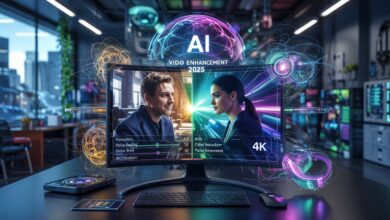Open Source AI Video Analysis: Tools, Applications, and Future Trends
Open Source AI Video Analysis in today’s digital era, video content dominates online platforms, from social media to surveillance systems, educational resources, and entertainment. The sheer volume of video data has created a pressing need for efficient analysis tools to extract meaningful insights. Open source AI video analysis has emerged as a powerful, accessible, and cost-effective solution, enabling businesses, researchers, and developers to process, interpret, and leverage video data without the constraints of proprietary software. This article explores the landscape of open source AI video analysis, highlighting key tools, real-world applications, benefits, challenges, and future trends. By diving deep into this transformative technology, we aim to provide a comprehensive resource for anyone looking to harness its potential.
What is Open Source AI Video Analysis?
Open source AI video analysis refers to the use of freely available, community-driven software and frameworks that leverage artificial intelligence (AI) to process and interpret video content. These tools combine computer vision, machine learning, and sometimes natural language processing to perform tasks such as object detection, motion tracking, behavior analysis, and automated captioning. Unlike proprietary solutions, open source tools allow users to access, modify, and distribute the source code, fostering innovation, collaboration, and customization.
The rise of open source AI video analysis is driven by the democratization of AI technologies, the availability of powerful libraries, and the growing demand for scalable video processing solutions. From academic research to commercial applications, these tools are transforming how we interact with video data.
Why Choose Open Source for Video Analysis?
Open source AI video analysis offers several advantages that make it an attractive choice for developers, researchers, and organizations:
- Cost-Effectiveness: Open source tools eliminate licensing fees, making advanced video analysis accessible to startups, small businesses, and individual developers.
- Flexibility and Customization: Users can modify the source code to tailor tools to specific needs, enabling unique applications in diverse fields like robotics, healthcare, or security.
- Community Support: A global community of contributors ensures continuous improvements, bug fixes, and extensive documentation, reducing the learning curve for new users.
- Transparency: Access to source code allows for security audits and ensures compliance with organizational standards, a critical factor for sensitive applications like surveillance.
- Innovation: The collaborative nature of open source fosters rapid development of new features and integrations, keeping pace with advancements in AI and computer vision.
Despite these benefits, challenges such as the need for technical expertise, data privacy concerns, and computational resource requirements must be addressed to maximize the potential of open source solutions.
Top Open Source AI Video Analysis Tools
Several open source tools have gained prominence in the field of AI video analysis, each offering unique features and capabilities. Below, we explore some of the most widely used tools, their functionalities, and their applications.
1. OpenCV
Overview: OpenCV (Open Source Computer Vision Library) is a cornerstone of computer vision and video analysis. This robust library supports real-time processing and is compatible with multiple programming languages, including Python, C++, and Java.Key Features:
- Object detection and tracking
- Motion analysis and segmentation
- Facial recognition
- Extensive documentation and community support Applications: OpenCV is used in robotics (e.g., autonomous navigation), surveillance (e.g., traffic monitoring), and augmented reality (e.g., real-time overlays). Its flexibility makes it ideal for both research and commercial projects.Why It Stands Out: OpenCV’s accessibility and active community make it a go-to choice for developers at all skill levels.
2. TensorFlow
Overview: Developed by Google, TensorFlow is a versatile machine learning framework that supports video analysis through custom model development. While not exclusively for video, its capabilities in training and deploying AI models make it a powerful tool for video processing.Key Features:
- Support for deep learning models like CNNs and RNNs
- Integration with hardware accelerators (e.g., GPUs, TPUs)
- Pre-trained models for video tasks Applications: TensorFlow is used for action recognition, video classification, and multimodal learning, often in academic research and enterprise solutions.Why It Stands Out: Its scalability and integration with other Google tools make it ideal for large-scale video analysis projects.
3. PyTorch
Overview: PyTorch, backed by Meta AI, is another leading machine learning framework popular for its dynamic computational graphs and ease of use. It is widely adopted in video analysis research.Key Features:
- Support for video-specific datasets (e.g., AVA, Moments in Time)
- Tools for building sequence-to-sequence models
- Active research community Applications: PyTorch powers projects like video captioning, pose estimation, and behavior classification, particularly in neuroscience and ethology.Why It Stands Out: Its flexibility and researcher-friendly design make it a favorite for cutting-edge video analysis experiments.
4. YOLO (You Only Look Once)
Overview: YOLO is an open source framework for real-time object detection, optimized for speed and accuracy. Its latest versions (e.g., YOLOv8) are widely used for video analysis tasks.Key Features:
- Real-time object detection and tracking
- Lightweight models for edge devices
- Support for multi-object tracking Applications: YOLO is used in security (e.g., detecting suspicious activities), retail (e.g., customer behavior analysis), and autonomous vehicles (e.g., pedestrian detection).Why It Stands Out: YOLO’s speed and efficiency make it ideal for real-time applications on resource-constrained devices.
5. DeepLabCut
Overview: DeepLabCut is an open source tool designed for pose estimation and behavior analysis, particularly in animal studies. It leverages deep learning to track body parts in videos.Key Features:
- Markerless pose estimation
- User-friendly interface for labeling
- Integration with deep learning frameworks like TensorFlow Applications: DeepLabCut is widely used in neuroscience and ethology to study animal behavior, such as tracking rodent movements in lab experiments.Why It Stands Out: Its focus on behavioral analysis and ease of use make it a niche but powerful tool for researchers.
Real-World Applications of Open Source AI Video Analysis
Open source AI video analysis is transforming industries by enabling innovative applications. Below are some key sectors where these tools are making an impact:
1. Healthcare
In healthcare, open source tools like OpenCV and DeepLabCut are used for patient monitoring and diagnostics. For example, video analysis can track patient movements to assess recovery progress or detect anomalies in medical imaging. These tools enhance diagnostic efficiency and ensure compliance with treatment protocols.
2. Education
In the education sector, AI video analysis tools analyze classroom interactions to assess student engagement and provide feedback to instructors. Open source solutions enable schools to implement these technologies without significant costs, fostering personalized learning environments.
3. Security and Surveillance
Security systems leverage tools like YOLO and OpenCV to analyze live feeds, detect suspicious activities, and enhance safety measures. For instance, open source frameworks can identify unauthorized access or monitor crowd behavior in real time.
4. Retail
Retail businesses use video analytics to understand customer behavior, optimize store layouts, and improve inventory management. Open source tools enable small retailers to access these insights without investing in expensive proprietary systems.
5. Autonomous Vehicles
Open source AI video analysis is critical for autonomous driving, where tools like YOLO and TensorFlow process video feeds to detect pedestrians, vehicles, and road signs in real time. These solutions ensure safety and reliability in self-driving systems.
6. Entertainment and Media
In the entertainment industry, open source tools support video editing, content recommendation, and automated subtitling. For example, sequence-to-sequence models built with PyTorch can generate captions for videos, improving accessibility for the visually impaired.
Challenges in Open Source AI Video Analysis
While open source AI video analysis offers immense potential, it comes with challenges that users must navigate:
- Technical Expertise: Implementing and customizing open source tools requires proficiency in programming and AI, which can be a barrier for non-technical users.
- Data Privacy: Analyzing video data, especially in surveillance or healthcare, raises concerns about privacy and compliance with regulations like GDPR. Organizations must anonymize data and secure transmissions.
- Computational Resources: Real-time video processing demands significant computational power, often requiring GPUs or cloud infrastructure, which may be costly for small teams.
- Data Quality: The accuracy of AI models depends on high-quality, diverse datasets. Poorly curated data can lead to unreliable results.
- Lack of Standardization: The open source ecosystem can be fragmented, with varying levels of documentation and compatibility, complicating tool selection and integration.
Future Trends in Open Source AI Video Analysis
The future of open source AI video analysis is promising, with several trends shaping its evolution:
- Integration with Large Language Models (LLMs): Combining video analysis with LLMs will enable more sophisticated applications, such as conversational video summarization or context-aware narration.
- Edge Computing: Advances in edge AI will allow video analysis to run on low-power devices, reducing latency and enabling real-time applications in IoT and autonomous systems.
- Multimodal Learning: Tools like PyTorch and TensorFlow are increasingly supporting multimodal models that combine video, audio, and text, enhancing tasks like action recognition and video captioning.
- Community-Driven Datasets: Initiatives like the AVA and Moments in Time datasets are fostering open sharing of video data, improving model training and reproducibility.
- Ethical AI: The open source community is prioritizing ethical considerations, such as bias mitigation and privacy-preserving techniques, to ensure responsible use of video analysis tools.
Conclusion
Open source AI video analysis is revolutionizing how we process and interpret video data, offering cost-effective, flexible, and innovative solutions for industries ranging from healthcare to entertainment. Tools like OpenCV, TensorFlow, PyTorch, YOLO, and DeepLabCut empower users to tackle complex video analysis tasks, from object detection to behavior classification. While challenges like technical expertise and data privacy persist, the collaborative nature of the open source community ensures continuous improvements and accessibility.
As the field evolves, trends like edge computing, multimodal learning, and ethical AI will shape the future of video analysis, making it more powerful and inclusive. For businesses, researchers, and developers, embracing open source AI video analysis is not just an opportunity but a necessity to stay competitive in a video-driven world. By leveraging these tools and staying informed about emerging trends, you can unlock the full potential of video data and drive meaningful impact in your domain.



